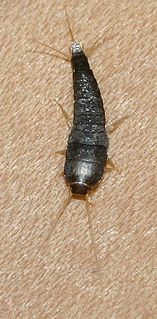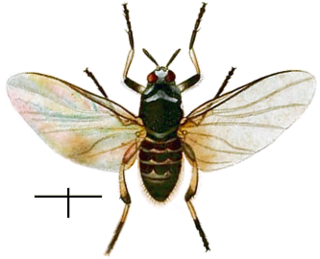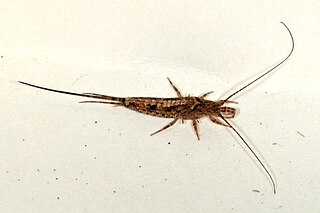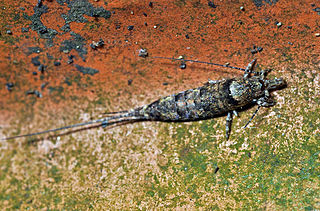
The Machilidae are a family of insects belonging to the order Archaeognatha. There are around 250 described species worldwide. These insects are wingless, elongated and more or less cylindrical with a distinctive humped thorax and covered with tiny, close-fitting scales. The colour is usually grey or brown, sometimes intricately patterned. There are three "tails" at the rear of the abdomen: two cerci and a long central epiproct. They have large compound eyes, often meeting at a central point. They resemble the silverfish and the firebrat, which are from a different order, Zygentoma.

Lepismatidae is a family of primitive wingless insects with about 190 described species. This family contains the two most familiar members of the order Zygentoma: the silverfish and the firebrat. It is one of five families in the order Zygentoma.

Ctenolepisma is a genus of primitive insects in the order Zygentoma, closely related to the silverfish and firebrat but less reliant on human habitation, some species being found both indoors and outdoors and some found exclusively outdoors. The genus is distributed nearly worldwide in warm regions. Australia lacks native Ctenolepisma, but is home to introduced species.

Simulium is a genus of black flies, which may transmit diseases such as onchocerciasis. It is a large genus with several hundred species, and 41 subgenera.
Gigantodax is a genus of 68 species of black flies distributed along the Andes from Mexico to Tierra del Fuego in Argentina.

Aenictopecheidae is a rare family of insects occurring worldwide but containing only a few species, including a single American species, Boreostolus americanus. This species lives under large, flat stones and sandy substrates along mountain streams in Oregon, Washington, and Colorado. It is 5 mm long and occurs in both the macropterous and brachypterous condition. It is assumed to be predaceous.
Neoasterolepisma is a genus of primitive insects belonging to the family Lepismatidae. Many species live with ants.

Ploiaria is a cosmopolitan genus of thread-legged bugs (Emesinae). There are presently about 130 described species.

Ploiariolini is a tribe of thread-legged bugs, comprising 16 genera and 142 described species. Ploiariolini has a worldwide distribution.

Phylinae is a subfamily of the plant bug family Miridae. Species of this family are found worldwide.
Charimachilis is a genus of the family Machilidae which belongs to the insect order Archaeognatha. They are found in southern and eastern Europe.
Lepidospora is a genus of silverfish in the family Nicoletiidae.
Machilinus is a genus of rock bristletails in the family Meinertellidae. There are about 17 described species in Machilinus.

Lepismachilis is a genus of jumping bristletails in the family Machilidae. There are more than 20 described species in Lepismachilis.
Meximachilis is a genus of jumping bristletails in the family Machilidae. There are at least three described species in Meximachilis.
Silvestrichilis is a genus of jumping bristletails in the family Machilidae. There are about eight described species in Silvestrichilis.
Trigoniomachilis is a genus of jumping bristletails in the family Machilidae. There are at least four described species in Trigoniomachilis.

Trigoniophthalmus is a genus of jumping bristletails in the family Machilidae. There are about 11 described species in Trigoniophthalmus.

Machiloides banksi is a species of rock bristletail, family of basal insects belonging to the order Archaeognatha, in the genus Machiloides.
Sceletolepisma is a genus of primitive insects closely related to the silverfish and firebrat but less reliant on human habitation, some species being found both indoors and outdoors and some found exclusively outdoors. The genus is distributed nearly worldwide in warm regions.










